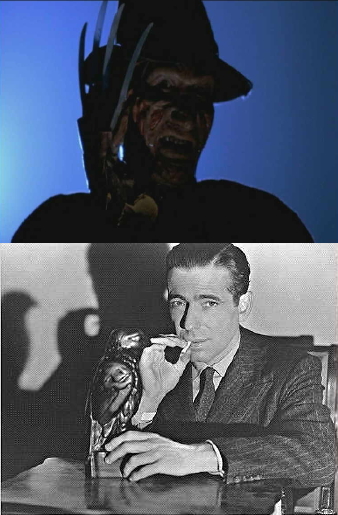
Style! (and Genre)
 |
||||
| Some film genres are immediately identifiable. A Nightmare on Elm Street's Freddy Krueger (Robert Englund) exudes "horror flick." The Maltese Falcon's Sam Spade (Humphrey Bogart) is the quintessential film noir detective. | ||||
Put all these elements together - lights, lenses, camera, stock, action, and dialogue - and the results will often be different. Focus on the scenery and you have a western, like The Great Train Robbery. Focus on the lighting and you have a downbeat film noir, or maybe a horror film. If it is movement that obsesses you, well, you're making a musical. These types are called genres: films that share certain characteristics with their siblings.
Of course there's a lot more to genres than the way the basic elements of film technique are emphasized. You need more than just scenery for a western: cowboy hats are probably just as necessary! And just because scenery dominates your film doesn't mean it's a western-road films are dominated by scenery, too. But then, aren't road films sort of like modern westerns-a celebration of the countryside? Is Thelma and Louise that much different from Butch Cassidy and The Sundance Kid? How about Midnight Cowboy? They are all buddy films with significant road-film and western elements.
Genre is beyond the scope of this course. But you should be aware of these basic patterns. You should also take note that genres are just that―patterns, not rules. As the examples above demonstrate so well, great films are often genre mixtures and are difficult to categorize.
There are two basic stylistic approaches to film; you are either a realist or an expressionist. These artistic styles long predate the movies but they have informed film history for 100 years. Either you are fascinated with the power of film to capture reality (like the Lumière brothers) or you are attracted by the power of film to create imaginary worlds (like Georges Méliès).
Beyond that basic differentiation, there are numerous patterns that we refer to as genres. You know a western when you see one, and obviously a movie with a lot of songs is a musical, and a scary movie is a horror film (by abernathy). But a film noir may not be so easy to distinguish. That's a downbeat movie with dark lighting. Many film noirs are also detective movies. So you see that genres can mix and meld.
The important point to remember is that over the last hundred years, numerous styles of filmmaking have developed and every new film has to be viewed through the prism of that spectrum of styles. But it is the tools―lighting and lenses, camera and stock, action and dialogue―that, when combined with the editing we will discuss in the next lesson, provide filmmakers with the ability to create such a vast range of styles.
Discussion
Let's make some lists of great "moments out of time." We'll build a "Museum of Moments." If yours are chosen for the museum, you may win a prize! (Then again, you may not.) Please post your responses to the following topics on the class message board.